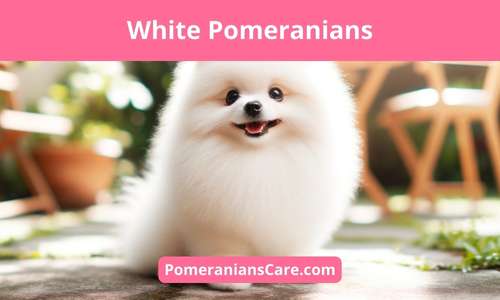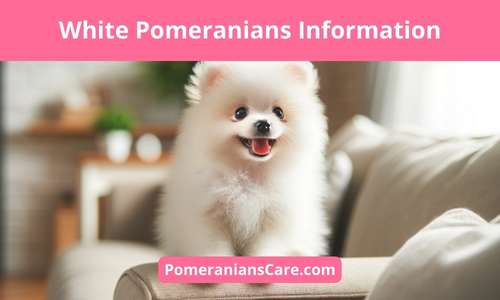Hello and welcome to all dog lovers! Have you ever noticed how a white Pomeranian can effortlessly capture attention with its elegant, snowy coat? These adorable, petite dogs are not just another beautiful breed; they embody a unique blend of charm and liveliness. white Pomeranians, with their distinct, pristine fur, hold a special place in the hearts of many. Whether you’re a seasoned Pomeranian enthusiast or considering welcoming one of these little bundles of joy into your life, this post is for you.
Characteristics of a White Pomeranian
White Pomeranian is not just visually stunning; they possess a range of characteristics that make them unique in both appearance and temperament. Let’s explore these traits.
Physical Features
- Coat: The most striking feature of a white Pomeranian is undoubtedly its beautiful, pure white coat. This plush, thick fur is a hallmark of the breed, giving them a soft, fluffy appearance that’s both luxurious and eye-catching.
- Size: As a member of the toy breed group, white Pomeranians are small and compact, typically weighing between 3 to 7 pounds. Their petite size makes them ideal companions for apartment living or for being a lapdog.
- Face: They often have a fox-like expression with a short, pointed muzzle, bright, almond-shaped eyes, and small, erect ears. This gives them an alert and curious look that’s full of personality.
- Tail: Their tail is another distinctive feature, profusely covered in long fur and curling over their back, adding to their regal appearance.

Temperament
- Intelligence: white Pomeranians are known for their intelligence and can be quite easy to train. This makes them suitable for a variety of activities, including agility and obedience competitions.
- Lively and Playful: Despite their small size, they are lively and have a playful nature. They enjoy being active and can be quite spirited when engaging in play or exploring new environments.
- Affectionate: They form strong bonds with their owners and are known for being affectionate and loving. white Pomeranians often enjoy cuddling and spending time with their human companions.
- Alert and Vocal: They are alert and can be quite vocal, often barking to express themselves or alert their owners to anything unusual in their environment.
- Socialization Needs: Early socialization is important for white Pomeranians to ensure they are well-adjusted and comfortable in various situations. They can sometimes be reserved or cautious around strangers, so positive social experiences are key.
In summary, white Pomeranians are much more than their stunning white coats. They are intelligent, lively, and affectionate dogs that make excellent companions. Their small size and distinctive appearance, coupled with their engaging personalities, make them a popular choice for dog lovers. Whether you’re looking for a playful companion or a loving lapdog, a white Pomeranian has a lot to offer.
What Makes a White Pomeranian Different
White Pomeranians are special for a few reasons:
- Their Color: The most obvious thing that sets white Pomeranians apart from other Pomeranians is their color. While Pomeranians come in many colors, white Pomeranians have a pure, bright white coat. This is different from other light-colored Pomeranians that might have shades of cream or beige.
- Grooming Needs: Because of their bright white fur, white Pomeranians might need more baths and brushing. Their fur can show dirt more easily than darker colors, so keeping them clean can be a bit more work.
- Popularity: White Pomeranians are quite popular and often seen as very stylish, partly because their unique color catches people’s eyes. They might get more attention than Pomeranians of other colors.
- Health Care: Sometimes, white dogs can have more sensitive skin. So, white Pomeranians might need extra care to protect their skin and keep them healthy.

In general, white Pomeranians are just like other Pomeranians. They are small, friendly, and full of energy. But their beautiful white coat makes them stand out and requires some extra care.
History and Origins of the White Pomeranian
The story of the white Pomeranian starts with the history of the Pomeranian breed itself. Pomeranians, originally larger sled-pulling dogs from the Arctic regions, were bred down to their small size in the Pomerania region of Central Europe, now part of Poland and Germany.
- Royal Influence: The transformation of Pomeranians into a fashionable breed of smaller size is often credited to royalty, especially Queen Victoria of England. She fell in love with a small Pomeranian and began breeding them to be even smaller. Her influence made the breed very popular.
- Breeding for Color: As Pomeranians became more popular, breeders started focusing on different colors, including white. Breeding specifically for the white coat color was challenging, as it required careful selection to maintain the purity and brightness of the coat.
- Rise in Popularity: Over time, the white Pomeranian became highly sought after due to its striking appearance. The pure white coat was rare and seen as particularly elegant and luxurious, making white Pomeranians a favorite among dog enthusiasts.
- Modern-Day Status: Today, white Pomeranians continue to be one of the most popular color variations of the breed. They are known for their distinctive fluffy white coats and lively personalities, making them beloved pets and show dogs.
In summary, the white Pomeranian’s journey from a larger sled dog to a small, elegant companion is a testament to the breed’s adaptability and the impact of selective breeding. Their striking white coats are the result of dedicated breeding efforts, making them a cherished variant of the Pomeranian breed.
Caring for a White Pomeranian
Taking care of a white Pomeranian involves some special attention, especially to their coat. Here’s a guide to help ensure your white Pomeranian stays healthy and happy:
Grooming
- Regular Brushing: Their fluffy coat needs regular brushing, at least three times a week, to prevent tangles and mats. This also helps to keep their fur looking bright and clean.
- Bathing: Bathe your white Pomeranian every few weeks with a dog-specific shampoo that’s gentle on their skin. This helps keep their coat white and removes any dirt or stains.
Diet and Nutrition
- Quality Food: Feed them high-quality dog food that suits their age, size, and activity level. Good nutrition is key to keeping their coat and skin in great condition.
- Hydration: Always ensure they have access to fresh water, as proper hydration is important for their overall health.

Exercise and Play
- Regular Exercise: White Pomeranians are energetic and need daily exercise. Short walks and play sessions help keep them fit and happy.
- Mental Stimulation: Provide toys and activities that keep their mind active. This breed loves to play and solve puzzles.
Health Care
- Regular Vet Check-ups: Regular visits to the vet are important to monitor their overall health and catch any issues early.
- Dental Care: Dental hygiene is important. Brush their teeth regularly to prevent dental problems.
- Skin Care: Keep an eye on their skin, as white Pomeranians can have sensitive skin. Look out for any redness or irritation.
Common Health Issues in White Pomeranians
While white Pomeranians are generally healthy, like all breeds, they can be prone to certain health issues. Here are some common health concerns to be aware of:
- Skin Sensitivities:
- Sun Sensitivity: Their white coat can make them more prone to sunburn. It’s important to limit their exposure to intense sunlight and consider using pet-safe sunscreen on exposed skin areas.
- Allergies: They may experience skin allergies, which can cause irritation and discomfort. Watch for excessive scratching or redness.
- Dental Issues:
- Pomeranians, including white ones, often face dental issues due to their small mouths. Regular dental check-ups and teeth cleaning are essential to prevent tooth decay and gum disease.
- Eye Problems:
- White Pomeranians can be susceptible to eye problems such as cataracts or tear duct issues. Regular eye check-ups can help catch and treat these issues early.
- Luxating Patella:
- A common issue in small breeds, luxating patella is a condition where the kneecap dislocates. This can cause pain and affect the dog’s ability to walk.
- Tracheal Collapse:
- This breed can be prone to tracheal collapse, a condition where the tracheal rings weaken, leading to breathing difficulties. Signs include a honking cough and trouble breathing.
- Heart Conditions:
- Some Pomeranians may develop heart issues as they age. Regular vet visits and monitoring for signs like fatigue or difficulty breathing are important.
- Obesity:
- Due to their small size, weight gain can be a significant health risk for white Pomeranians. Maintaining a healthy diet and regular exercise is crucial.
- Hypoglycemia:
- Especially in younger and smaller Pomeranians, low blood sugar levels can be a concern. Monitoring their diet and feeding them small, regular meals can help.
Training and Socializing White Pomeranians
Proper training and socialization are crucial for white Pomeranians to become well-behaved and confident pets. Here are some tips to guide you:
Start Training Early
- Basic Commands: Begin with basic commands like ‘sit’, ‘stay’, ‘come’, and ‘heel’. White Pomeranians are intelligent and can learn quickly with the right approach.
- Positive Reinforcement: Use treats, praise, and play as rewards. This breed responds well to positive reinforcement rather than harsh corrections.
Consistency is Key
- Routine Training: Establish a regular training routine. Consistent training helps white Pomeranians understand what is expected of them.
- House Training: House training is important. Due to their small size, they can be a bit more challenging to housebreak, so patience and consistency are vital.
Socialization
- Expose to Various Settings: Introduce your white Pomeranian to different environments, sounds, people, and other animals from a young age. This helps them become well-adjusted and reduces fear or anxiety in new situations.
- Puppy Classes: Consider enrolling in puppy socialization classes. These provide a safe environment for social learning and early exposure to other dogs.
Addressing Barking
- White Pomeranians can be vocal. Train them to understand a ‘quiet’ command to manage excessive barking.
- Understand the cause of the barking. If it’s due to anxiety or seeking attention, address the root cause.
Leash Training
- Teach them to walk calmly on a leash. This is essential for their safety and for enjoyable walks.
Avoid Small Dog Syndrome
- Don’t let their small size lead to a lack of discipline. Small dogs can develop behavioral issues if they’re not given boundaries and structure.
Ongoing Socialization
- Continue to expose them to new experiences throughout their life. This helps maintain their social skills and prevents them from becoming overly territorial or anxious.
Mental Stimulation
- Provide puzzle toys and games to keep their minds active. Mental stimulation is as important as physical exercise for this breed.
Gentle Handling
- Teach children and others to handle your white Pomeranian gently. Due to their small size, they can be easily injured by rough handling.
Training and socializing your white Pomeranian can be a rewarding experience. It not only enhances their behavior but also strengthens the bond between you and your pet. With patience, love, and consistent training, your white Pomeranian will grow into a well-mannered and sociable companion.
More Pomeranian Types
- Pomeranian Husky – Everything You MUST Know [POMSKY DOG]
- Everything You Should Know About a Teacup Pomeranian: Facts, Price, Care Guide and More
- Pomeranian Mixed With Pitbull – Everything You Must Know [PIT POM]
- Fox Face Pomeranian: The Most Important Things To Know
- The Merle Pomeranian: Everything You Must Know




 No products in the cart.
No products in the cart.